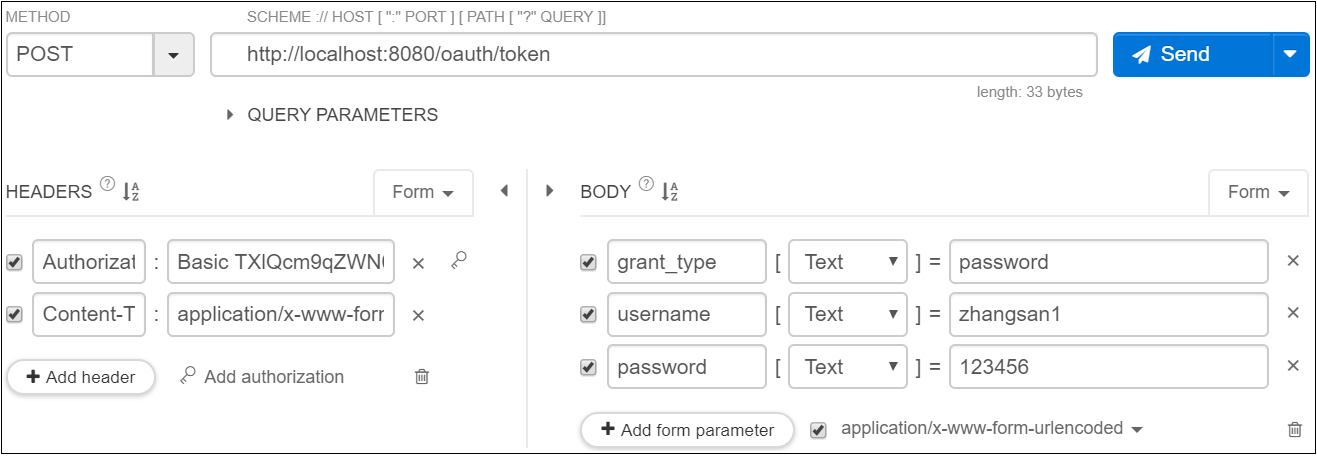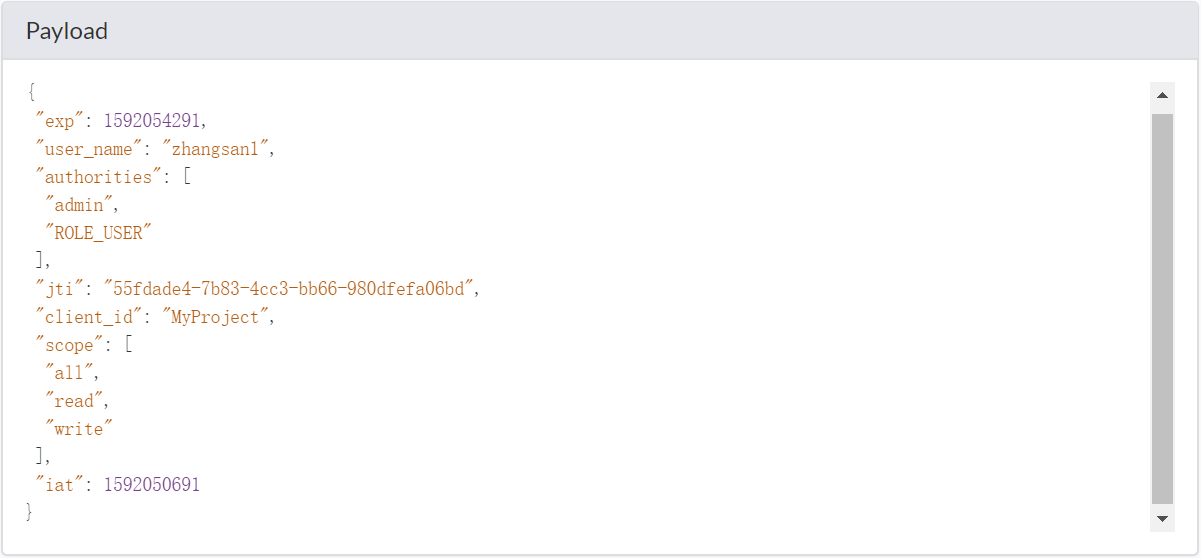SpringSecurityOAuth2之JWT应用示例
本文记录一下使用SpringSecurityOAuth2配置JWT的步骤
1、相关知识
OAuth协议简介:https://www.cnblogs.com/javasl/p/13054133.html
OAuth 2.0官网:https://oauth.net/2/
使用SpringSecurityOAuth2默认实现OAuth2授权示例:https://www.cnblogs.com/javasl/p/13060284.html
使用SpringSecurityOAuth2配置自定义Token实现OAuth2授权示例:https://www.cnblogs.com/javasl/p/13068613.html
2、JWT基础
JWT全称是Json Web Token,它是JSON的一个开放的Token标准。JWT有三个特点:
1)自包含。JWT中包含着Token有意义的信息,拿到Token,解析后就能知道里面包含的信息是什么,而Spring默认生成的Token是UUID,没有任何有意义的信息。它的信息需要根据这个Token去Redis中读取。
2)密签。发出去的令牌不包含密码等敏感信息,使用指定的秘钥签名。
3)可扩展。包含的信息可以根据业务需求自己定义。
2、构建项目
本文使用的springboot版本是2.0.4.RELEASE,不同版本可能会有所区别。下面是主要的配置文件和类:
1)pom依赖
<dependency>
<groupId>org.springframework.boot</groupId>
<artifactId>spring-boot-starter-security</artifactId>
</dependency>
<dependency>
<groupId>org.springframework.security.oauth.boot</groupId>
<artifactId>spring-security-oauth2-autoconfigure</artifactId>
<version>2.1.3.RELEASE</version>
</dependency>
2)application.properties
#不需要,暂时写死在代码中,重构时移植到此处即可
3)主配置类
@EnableWebSecurity @Configuration public class WebSecurityConfig extends WebSecurityConfigurerAdapter{ @Override protected void configure(HttpSecurity http) throws Exception { http.httpBasic().and().csrf().disable(); } @Bean("authenticationManager") public AuthenticationManager authenticationManagerBean() throws Exception { return super.authenticationManagerBean(); } @Bean public PasswordEncoder passwordEncoder() { return new BCryptPasswordEncoder(); } }
4)用户认证类
@Component public class MyUserDetailsService implements UserDetailsService{ @Autowired private PasswordEncoder passwordEncoder; @Override public UserDetails loadUserByUsername(String username) throws UsernameNotFoundException { System.out.println("登录用户名:"+username); String password = passwordEncoder.encode("123456"); return new User(username,password,true,true,true,true, AuthorityUtils.commaSeparatedStringToAuthorityList("admin,ROLE_USER")); } }
5)认证服务类
@Configuration @EnableAuthorizationServer public class AuthorizationServerConfig extends AuthorizationServerConfigurerAdapter{ @Autowired private AuthenticationManager authenticationManager; @Autowired private UserDetailsService userDetailsService; @Autowired private PasswordEncoder passwordEncoder; @Autowired private TokenStore tokenStore; @Autowired private JwtAccessTokenConverter jwtAccessTokenConverter;
@Override public void configure(AuthorizationServerEndpointsConfigurer endpoints) throws Exception { endpoints .tokenStore(tokenStore)//如果使用RedisTokenStore,则会把Token存入redis中,否则存在内存 .accessTokenConverter(jwtAccessTokenConverter) .authenticationManager(authenticationManager) .userDetailsService(userDetailsService); } @Override public void configure(ClientDetailsServiceConfigurer clients) throws Exception { clients .inMemory()//Token保存在内存中 .withClient("MyProject").secret(passwordEncoder.encode("MyProject_123"))//指明client-id和client-secret .accessTokenValiditySeconds(7200)//令牌有效时间,单位秒 .authorizedGrantTypes("refresh_token","password","authorization_code")//支持刷新令牌、密码模式、授权码模式 .scopes("all","read","write")//权限有哪些,如果这两配置了该参数,客户端发请求可以不带参数,使用配置的参数 .redirectUris("http://127.0.0.1:8080/login"); } }
6)JWT配置类
@Configuration public class JwtTokenConfig { @Bean public TokenStore jwtTokenStore() { return new JwtTokenStore(jwtAccessTokenConverter()); } @Bean public JwtAccessTokenConverter jwtAccessTokenConverter() { JwtAccessTokenConverter accessTokenConverter = new JwtAccessTokenConverter(); accessTokenConverter.setSigningKey("shxiang");//设置秘钥 return accessTokenConverter; } }
说明:上一篇讲到RedisTokenStore,这里又有JwtTokenStore,一定要区分开。
a)如果TokenStore的注入类型是RedisTokenStore,则生成的JWT会存入redis中。
b)如果TokenStore的注入类型是JwtTokenStore,或者endpoints不设置TokenStore,那么生成的JWT在内存中。
7)启动类
@SpringBootApplication public class App { public static void main(String[] args) { SpringApplication.run(App.class, args); } }
4、测试验证
1)获取Token成功


2)将Token复制到https://www.jsonwebtoken.io/解析Token成功

3)根据Token获取当前用户信息
@GetMapping("/me")
public Object getCurrentUser(Authentication user) {
return user;
}


说明:上面是密码模式的测试,授权码模式的测试请参考上一篇的测试验证部分。
5、扩展自定义字段
1)添加Token增强类
public class MyJwtTokenEnhancer implements TokenEnhancer{ @Override public OAuth2AccessToken enhance(OAuth2AccessToken accessToken, OAuth2Authentication authentication) { Map<String,Object> info = new HashMap<String, Object>(); info.put("company","test test test");//拓展的字段 ((DefaultOAuth2AccessToken)accessToken).setAdditionalInformation(info); return accessToken; } }
2)修改JwtTokenConfig.java,添加jwtTokenEnhancer方法创建bean
@Bean @ConditionalOnMissingBean(name = "jwtTokenEnhancer") public TokenEnhancer jwtTokenEnhancer() { return new MyJwtTokenEnhancer(); }
3)修改AuthorizationServerConfig.java的configure方法,如下:
@Configuration @EnableAuthorizationServer public class AuthorizationServerConfig extends AuthorizationServerConfigurerAdapter{ ... ... @Autowired private JwtAccessTokenConverter jwtAccessTokenConverter; @Autowired private TokenEnhancer jwtTokenEnhancer; @Override public void configure(AuthorizationServerEndpointsConfigurer endpoints) throws Exception { endpoints .authenticationManager(authenticationManager) .userDetailsService(userDetailsService); TokenEnhancerChain enhancerChain = new TokenEnhancerChain(); List<TokenEnhancer> enhancers = new ArrayList<>(); enhancers.add(jwtTokenEnhancer); enhancers.add(jwtAccessTokenConverter); enhancerChain.setTokenEnhancers(enhancers); endpoints.tokenEnhancer(enhancerChain); endpoints.accessTokenConverter(jwtAccessTokenConverter); } ... ... }
测试结果如下:



注意:拓展的字段不会封装到用户信息Authentication中,执行http://localhost:8080/me不会获取到拓展字段。
6、获取自定义字段
1)添加pom.xml依赖
<dependency>
<groupId>io.jsonwebtoken</groupId>
<artifactId>jjwt</artifactId>
<version>0.7.0</version>
</dependency>
2)测试方法如下
@GetMapping("/me")
public Object getCurrentUser(Authentication user,HttpServletRequest request) throws ExpiredJwtException, UnsupportedJwtException, MalformedJwtException, SignatureException, IllegalArgumentException, UnsupportedEncodingException {
String header = request.getHeader("Authorization");
String token = StringUtils.substringAfter(header,"bearer ");
Claims claims = Jwts.parser().setSigningKey("shxiang".getBytes("UTF-8"))//shxiang是秘钥
.parseClaimsJws(token).getBody();
String company = (String)claims.get("company");
System.out.println("-------company----------:"+company);
return user;
}
结果如下:


7、Token的刷新
获取令牌的时候会获取access_token和refresh_token,如下图所示:

使用refresh_token可以刷新Token,如下:


当用户使用Token访问时,发现超时了,在无感知的情况下立马使用refresh_token请求一个新的Token。refresh_token设置较长时间,如:
.accessTokenValiditySeconds(7200)
.refreshTokenValiditySeconds(2592000)



 浙公网安备 33010602011771号
浙公网安备 33010602011771号